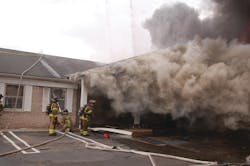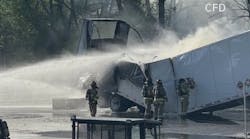On Wednesday, Dec. 1, 2010, a four-alarm fire destroyed the Harvard Plaza office building in Southfield, MI. Early recognition of possible backdraft conditions prevented injuries to firefighters when a backdraft did occur. Recognizing that water supply would be an issue during a major fire with prolonged master-stream use, incident commanders notified the water company early in the incident to increase the available water.
The one-story, 42,000-square-foot building was built in 1968. Construction consisted of ordinary-wood frame with brick exterior walls. The roof was of flat membrane construction with a gable roof around the perimeter. There were two fire walls located on the north and south sides of the building. More than 40 tenants occupied the building, including law firms, medical offices, accounting firms and charitable organizations.
Initial Dispatch
The Southfield Fire Department was dispatched for a report of a "smoke smell" in the Harvard Plaza at 29350 Southfield Road at 12:55 P.M. Responding on the call were Engines 3 and 5, both 1,500-gpm pumpers with two-person crews; Tower 5, a 100-foot tower ladder with a 1,250-gpm pump and a two-person crew; Life Support Ambulance 3 with a two-person crew, and Captain Ed Cary and Battalion Chief Keith Rowley in a command vehicle. While these units were responding, dispatch received multiple calls from the office building reporting that the smoke was increasing and that flames could be seen. Rowley requested Southfield Engines 1, 2 and 4, all 1,500-gpm pumpers, to respond to the scene.
Engine 3 and Ambulance 3 arrived on scene first and were positioned on side C. Occupants of the building were self-evacuating upon arrival of Engine 3. Engine 3 laid a 150-foot, five-inch supply line from a hydrant at the C/D corner. Engine 3 Lieutenant Niles Owen established "Southfield Road Command" and notified that the company was stretching a 200-foot, 1¾-inch attack line into the entrance on side C. Tower 5 was positioned on side C and supplied with a 100-foot, five-inch line from Engine 3.
Owens reported that the crew was doing a primary search using a thermal imaging camera because smoke conditions were rapidly getting worse. The crew was encountering moderate heat and heavy smoke in the northeast corner of the building. The fire had broken through the roof on the C/D corner and interior conditions were deteriorating rapidly. Rowley ordered the interior crew to evacuate the building.
Approximately 50 seconds after the interior crew exited the building, a backdraft occurred. The explosion blew out the entrance doors to the building on sides C and D. Heavy fire was now spreading from the B/C corner toward the C/D corner. Rowley had assumed command and ordered no entry into the structure and to begin defensive operations. At 1:05 P.M., he requested a mutual aid aerial from the Royal Oak Fire Department. Aerial 1, a 114-foot tower ladder with a 1,800-gpm pump, responded with four firefighters. Rowley also requested an additional engine from the Birmingham Fire Department at 1:08 P.M. Engine 2, a 1,250-gpm pumper, responded with four firefighters.
Royal Oak Aerial 1 arrived on scene at 1:10 and was set up for aerial master-stream operations on side B. This unit hooked onto a hydrant at the A/B corner of the building. Birmingham Engine 2 arrived at 1:12 and was positioned on side A. This engine was supplied from a hydrant on Southfield Road and placed its deck gun into operation
Defensive Operations
Fourteen minutes after the arrival of Engine 3, Rowley ordered all companies to begin defensive operations. Southfield Engines 2 and 3 placed their deck guns into operation. Tower 5 placed two aerial master streams into operation. Despite the use of master streams, the fire continued to rapidly spread to the east. Winds that reached 20 mph were pushing the fire into the east parking lot, where Engine 3 and Tower 5 were located. Both of these units had to be repositioned away from the heat and flames. The fire continued to spread, eventually involving the entire structure. The entire roof collapsed.
Rowley requested additional mutual aid as the fire continued to spread. At 1:17, Bloomfield Township Fire Department was requested to send an additional engine to the scene. Engine 3, a 1,250-gpm pumper, responded with a crew of four. Bloomfield Engine 3 arrived on scene at 1:26 and was positioned on side D. This engine was supplied by Southfield Engine 4, which was hooked onto a hydrant at the A/D corner. Engine 3 placed its deck gun into operation and firefighters deployed two 2½-inch attack lines into operation on side D.
Farmington Hills was requested to send an additional tower ladder to the scene at 1:54 P.M. Farmington Hills responded with a 75-foot TeleSquirt with a 1,500-gpm pump and a crew of four. This tower ladder arrived on scene at 2:15 and was set up on side A for aerial master-stream operations. This unit was supplied by a five-inch line from a hydrant on the opposite side of Southfield Road. At 2:30, the West Bloomfield Fire Department was requested to send the county light-and-power pod unit, consisting of a 10,000-watt generator and lights to the scene.
Rowley declared the fire under control at 5:30 P.M. All mutual aid units were released by 7 P.M. The last Southfield units left the scene at 8:50 P.M.
Conclusion
Forty-six firefighters operated eight engines and three aerial devices at the scene. Six handlines, four portable monitors, four deck guns and six aerial master streams were used to battle the fire. Firefighters used nearly 1.4 million gallons of water to extinguish the fire. There were no civilian or firefighter injuries. The weather at the time of the fire was overcast and cold with 15- to 20-mph winds from the west.
A 48-hour investigation by the Southfield Fire Department Fire Prevention Division determined that the fire was caused by a faulty electrical charging unit. Damage was estimated at $1.5 million to the building and $1.5 million to the contents. Initial positioning of Engine 3 and Tower 5 placed these two units in danger when the fire spread out of control.
Successes at the incident included:
- The early recognition of possible backdraft conditions prevented any injuries to firefighters when the backdraft occurred, blowing out entrance doors
- Training with the use of thermal imaging cameras enabled the interior crew to search more of the building before being withdrawn
- Incident commanders knew that water supply would be an issue during a major fire
- Early notification of the water company enabled increased water supply and training on relay pumping operations ensured the adequate supply of water for prolonged master-stream use
- Recognizing the need and calling for mutual aid early provided the necessary resources when needed
JAY K. BRADISH/IFPA, Firehouse® news editor, is a former captain in the Bradford Township, PA, Fire Department. He has been a volunteer firefighter and fire photographer for more than 25 years.






